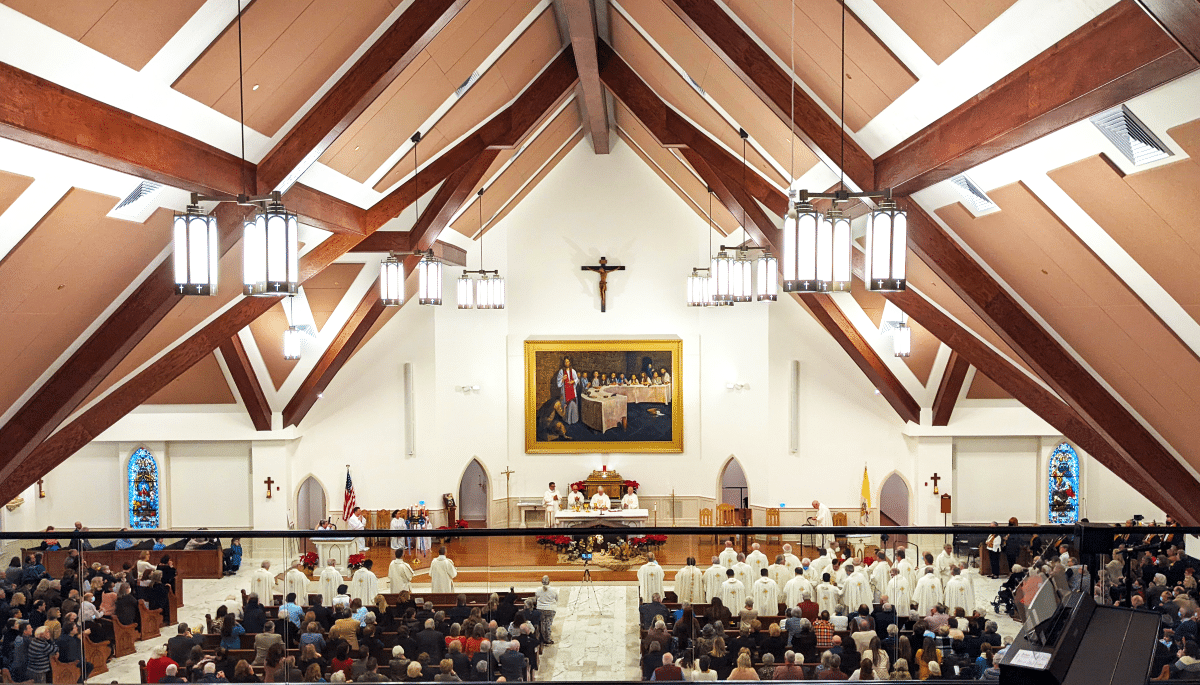In houses of worship, audio clarity is essential for community and connection. To engage with the message, the congregation must hear both speech and music clearly. However, worship environments often face unique acoustic challenges due to design considerations of the buildings themselves.
Many sanctuaries are designed to impart a sense of awe, with high ceilings, majestic artwork or stained glass windows expressing humanity’s reverence for the divine. But while beautiful architecture can create a dynamic worship environment and work well to amplify choral music, the highly reverberant acoustics can lead to poor speech intelligibility.
Even smaller worship spaces often have to deal with muffled or inconsistent audio due to higher reverberation levels and reflections. And contemporary houses of worship, like rock-and-roll churches, still need clear, intelligible speech and music to reach everyone in the congregation. Ensuring the sound system has enough power and directivity — without visually distracting the worshippers — is crucial.
Thankfully, when addressing these challenges, houses of worship have great options to craft a sound system that meets their community’s needs.
Taming the Reverberation
Reverberation is one of the main culprits behind poor acoustics in many houses of worship. Sound waves bounce off the floor, walls, ceiling and other reflective surfaces, gradually losing energy over time. The more hard surfaces in the space, the longer it takes for the sound to decay and the greater the reverberation — and the worse speech intelligibility becomes.
Simply put, speech intelligibility is the percentage of speech a listener can understand. While services often feature music reproduction, they always have spoken word, so the sound system first and foremost must ensure the message is clear. Intelligibility is affected by the volume level and quality of the speech signal, the type and level of background noise, room reverberation and more.
The first step to improving a room’s acoustics is establishing a baseline. You can’t know what to fix until you better understand what you’re dealing with. Having an AV consultant or acoustician model and measure the room’s acoustic profile is an excellent starting point. The results can be input into an acoustic modeling simulator like EASE software to understand how different loudspeaker models and placements would impact audio performance in the space. Most loudspeaker manufacturers have performance data available in EASE-compatible formats so that you can import their profiles directly into the software for realistic simulations.
While selecting the ideal loudspeaker solution for the space and identifying the proper installation points are both critical, other things can be done to the space to help reduce reverb. Using acoustical treatments to break up hard surfaces can be an excellent option. There’s a wide gamut of treatments available varying in cost and effectiveness, but any soft surface, such as drapes, carpeting or tapestries, will help reduce sound wave propagation. You can experiment at home by testing the acoustics in a bathroom before and after removing the towels and any rugs to see how much difference they make.
However, many houses of worship prefer not to use acoustic treatments over concern that they compromise the grandeur of the space. That’s where other factors like loudspeaker selection and placement become essential.
Choosing Which Loudspeakers Are the Best Fit
The goal for any house of worship sound system is consistent front-to-back audio coverage, meaning the people at the front of the room hear sound at approximately the same volume and intelligibility as those in the back. In reverberative environments, loudspeakers with poor directionality or those mounted in suboptimal locations can actually worsen the room’s intelligibility. Choosing the right loudspeakers can make all the difference between clear, consistent audio and alienating the congregation.
One benefit of house-of-worship environments is that people often gather in discrete seating areas. Rather than elevating the acoustics everywhere, which can be costly, sound system designers can tailor an audio solution to prioritize specific audience zones.
This means loudspeakers with high directivity, such as digitally steerable arrays, are an excellent solution. Loudspeaker directivity (aka “dispersion pattern”) is the extent to which loudspeakers focus sound in a particular direction instead of broadcasting it all around the room. By keeping sound away from other surfaces that may cause echoes and reverberation, digital arrays ensure intelligible speech and natural music reproduction for an engaging service. The sound coverage can be perfectly tailored to the environment with software-based adjustments on the fly without needing physical modifications if the room layout changes.
Balancing Aesthetics and Acoustics
Many houses of worship seek to cultivate a beautiful and reverential environment, but some traditional loudspeakers can compromise sightlines, intrude on the architecture or otherwise distract worshippers. Thankfully, some great options exist that achieve excellent acoustics without compromising aesthetics.
One option is to look for loudspeakers with a discrete or unobtrusive form factor. Column loudspeakers, for instance, feature tall, narrow enclosures, allowing them to fit and blend into architecture more easily than other loudspeaker styles.
Mounting locations are another thing to consider. Loudspeakers that can be mounted directly to the wall or flush inside the wall are much easier to blend into the background and are often more cost-effective than flying a line array. If the loudspeaker manufacturer also supports custom paint schemes for their cabinets, allowing them to be color-matched to the architecture, so much the better for having loudspeakers “disappear” and not act as a visual distraction.
Realistically, the fewer loudspeakers deployed, the fewer visual distractions for the worshippers. Beam steering loudspeakers can be beneficial here as they can cover multiple audience areas from a single loudspeaker location. For example, loudspeakers mounted in the back of the nave could have some beams directed at the worship team while others were directed at the congregation. This also positively impacts installation since there are fewer cables to run and fewer loudspeakers to mount. Using fewer loudspeakers can be particularly advantageous in historic houses of worship with limitations on structural changes, even down to the level where holes can be drilled.
Great Sound for Grand Spaces
Audio quality must accentuate the architecture to create truly immersive worship experiences for the congregation. When parishioners struggle to understand the sermon, they are distanced from the message and plagued by audio fatigue. From acoustic treatments to digital arrays to optimal loudspeaker placement, congregations have many options to improve the audio experience. Creating an acoustic model of the room goes a long way toward identifying the current challenges so you can craft the right solution for your unique space. The improvements can be a revelation.
Joe Fustolo is the Eastern Regional Sales Manager for Renkus-Heinz, a leading loudspeaker manufacturer, www.renkus-heinz.com.













